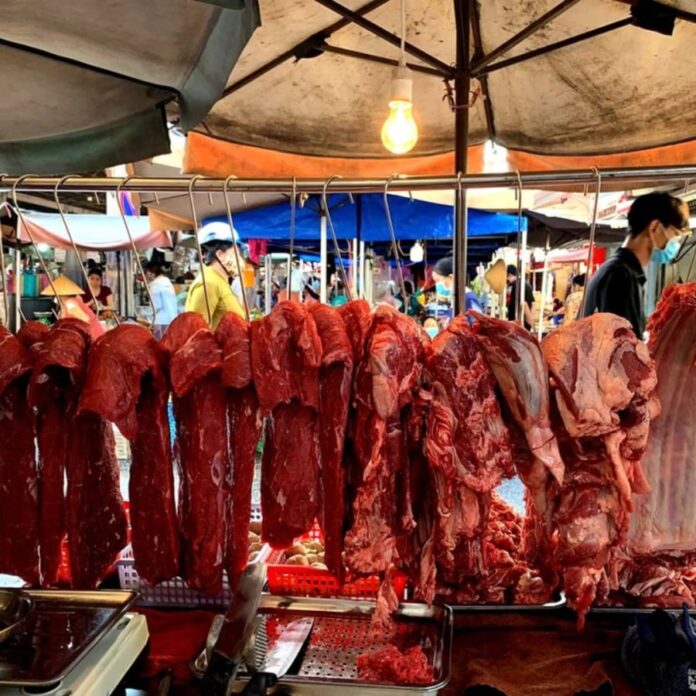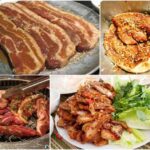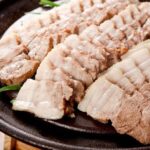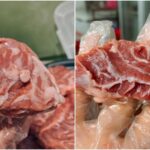There’s an intriguing observation to be made at traditional markets: Beef is often hung from iron hooks, while pork is displayed on tables or chopping boards. This practice is not random but stems from various factors related to meat characteristics, consumer habits, food hygiene, and business strategies. So, what’s behind this difference? Let’s delve into the details below.
1. Structural Characteristics and Properties of Beef
Beef has a firm texture, less fat, and distinct muscle fibers. Hanging beef allows these fibers to relax and stretch naturally, avoiding compression or distortion. This method enables buyers to easily inspect different cuts of meat and select the most suitable piece for their intended purpose, be it stir-frying, stewing, or grilling.
Additionally, hanging beef ensures a drier surface, reducing moisture from contact with tables or chopping boards. This not only enhances hygiene but also makes the meat appear fresher and more appealing to customers.
The uniform lean structure of beef sold in markets means that hanging it doesn’t compromise its aesthetic value. Moreover, hanging the meat demonstrates to customers that it is good quality, not defrosted, and hasn’t been injected with water. If the beef is of inferior quality, hanging it will cause it to drip, revealing its lack of freshness.

2. Why is Pork Usually Placed on Tables?
In contrast to beef, pork has a softer texture and contains more fat. It is also commonly prepared in various cuts like bacon, loin, shoulder, and ribs. Placing pork on a table facilitates easier categorization, chopping, slicing, or mincing according to customer requests. Additionally, certain cuts like ribs or hocks require a large chopping board and knife for proper butchering.
Furthermore, hanging pork may lead to deformation due to the softness and weight of the meat, causing tears in the muscle fibers and accelerating moisture loss, which affects freshness and daily preservation.
Pork has a composition of fat, lean meat, and skin. When hung, the fat and skin may be exposed, making the meat appear less appetizing compared to when it is laid out on a table.
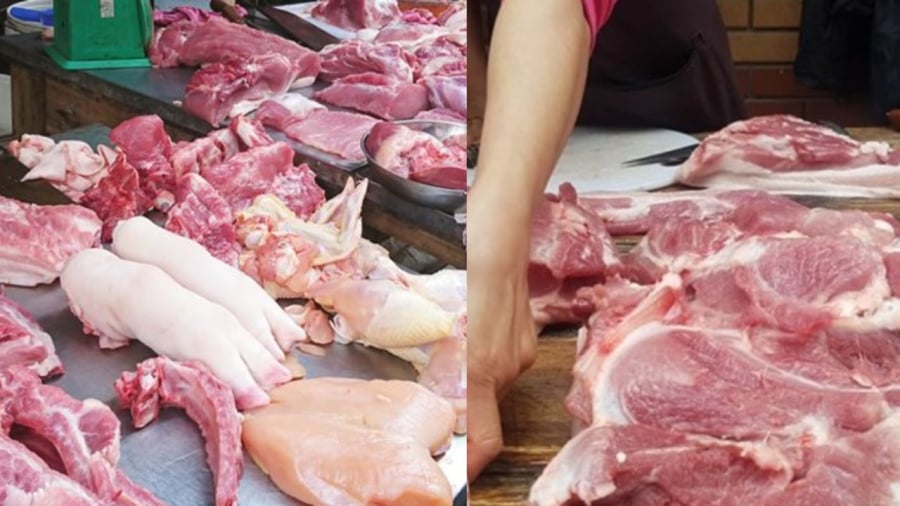
3. Hygiene and Meat Preservation Considerations
Hanging beef keeps it away from dust, flies, and potential bacterial contamination from unsanitary surfaces. Meanwhile, pork is typically processed and consumed at a faster rate, with vendors regularly sanitizing knives, chopping boards, and cloths to ensure maximum hygiene.
However, hanging beef is not entirely “sterile.” In many markets, vendors use fans, nets, or glass cabinets to protect the meat from insects, ensuring food safety.
4. Aesthetics and Customer Attraction
Beef is generally more expensive than pork, so vendors tend to display it prominently to attract attention. Hanging beef at eye level makes it easily visible from a distance, creating a perception of “cleanliness” and “premium quality.” This is a subtle business strategy that elevates the product’s value in consumers’ eyes.
On the other hand, pork, with its more affordable price point and frequent presence in daily meals, doesn’t require such prominent display methods, and its sales are less influenced by visual presentation.
5. Consumer Habits and Traditional Market Culture
In traditional Vietnamese markets, consumers are accustomed to choosing pork by touch, pressing it to assess elasticity. Therefore, placing pork on a table facilitates this tactile inspection.
Conversely, beef, with its drier and chewier nature, is often evaluated visually. Hanging it allows for better observation of color, marbling, fat content, and dryness.
6. Additional Reasons
Space Efficiency: Hanging beef saves valuable counter space, especially in smaller stalls. Vendors can hang the meat and utilize the table space for pork or other prepared items.
Convenience in Portioning: Beef is often cut along the long muscle fibers, so hanging it makes it more convenient to slice it along these fibers.
The practice of hanging beef and placing pork on tables is rooted in various factors, including meat characteristics, hygiene, preservation methods, consumer habits, and business strategies. Understanding these reasons provides consumers with peace of mind and helps them make informed choices when shopping for meat in traditional markets.
The Ultimate Guide to Boiling Meat: A Surefire Way to Eliminate Odor and Enhance Flavor
Introducing the ultimate guide to boiling meat: while it may seem simple, achieving that delicious taste is an art. Say goodbye to off-putting odors and hello to mouthwatering flavors. With our expert tips, you’ll learn how to transform even the strongest-smelling meats, from goat to duck and beef to tripe, into a delectable feast. No more unpleasant surprises from less-than-fresh pork – it’s time to reclaim your appetite!


























